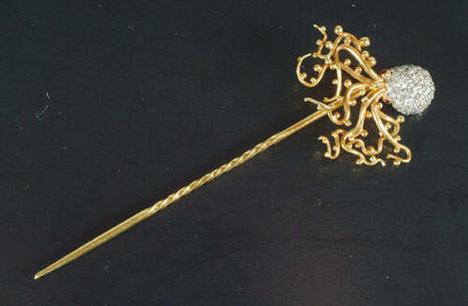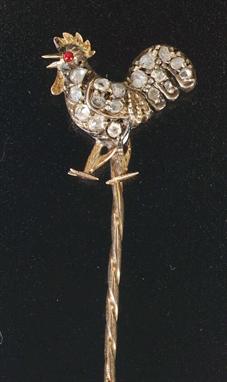We found 133746 price guide item(s) matching your search
Receive email alerts when new lots matching "stick" come up for sale.
Receive email alerts when new lots matching "stick" come up for sale.
There are 133746 lots that match your search criteria. Subscribe now to get instant access to the full price guide service.
Click here to subscribe- List
- Grid
-
133746 item(s)/page
A group of seven Swiss Black Forest items, mostly early 20th century, comprising an inkstand, carved with a parrot flanked by a letter rack and an inkwell; two nutcrackers, carved with dog's heads; two walking stick handles, carved with dogs; a corkscrew, with a handle carved as a terrier; a clothes brush, the holder carved as a bear
A single strand of facetted garnet beads, composed of 7mm facetted garnets to a snap clasp set on both sides with a foiled cabochon garnet; a pair of early 19th century flat cut garnet pendent earrings, the foiled garnets set in cut down collets (fittings missing); an early 19th century flat cut garnet cross, the foiled garnets set in cut down collets with half pearl accents (one garnet collet detached); four variously cut garnet brooches; and a Bohemian garnet and half pearl stick pin
A Regency flat cut garnet necklace, circa 1820, with three flower head clusters at the centre to a necklace of foliate links, set throughout with foiled flat cut garnets in gold cut down collets, to a garnet snap clasp, with a similarly set removable pendant; a pair of George III gold and flat cut garnet drop earrings, circa 1780, the three foiled garnet drops in cut down collets, suspended from a scrolled bar and garnet top, with shepherd’s hook fittings; and a flat cut garnet stick pin; all in a burgundy leather bound case with a West & Son, Capel Street (Dublin) stamp
A Victorian silver desk stand, Robinson, Edkins and Aston, Birmingham 1846, the shell moulded, shaped stand with a central baluster well flanked supporting a leaf and shell caster stick and snuffer, by a glass and silver mounted jar to either side, raised on four shell moulded bracket feet, 23cm wide, along with three Samson Mordan and Co pens
A Collection of Durham Light Infantry Related Militaria, including a heart shaped pin cushion, a framed display of stay-brite helmet plates and cap badges, a swagger stick, a shell case companion set, a brass shell case, a black painted iron brand stamp with T shaped handle, Kensita silks, an embroidered silk handkerchief, sweetheart brooches, buttons, badges, titles, divisional flashes, four Sergeant's Mess plates for the 6th Battalion and ephemera.
A 19th Century Sword Stick, the single edge fullered steel blade engraved with tendrils, with ebony grip and snakeskin covered scabbard; two machetes, each with clip point blade engraved with Shakespearian verses, brass cross guard and polish cow horn curved grip; a fencing foil; a horn handled machete-5
A FINE 140-BORE BREECH-LOADING WALKING-STICK AIR RIFLE WITH STIRRUP PUMP BY WM. WATSON, LONDON, Circa 1870, with 17 1/2in. barrel with multigroove rifling, rotating breech, button trigger, the barrel and reservoir painted to simulate wood, dark horn handle (cracked), the face of the reservoir signed 'W. WATSON & SON / LONDON', brass barrel-cap, stirrup pump with browned twist stem signed 'WM. WATSON & SON. 308 & 313 HIGH HOLBORN. LONDON', and case-hardened foot-plate, much original finish throughout, contained in an old purpose-made woollen slip.
AN 18-BORE DICKSON PATENT PERCUSSION WALKING STICK RIFLE BY J. LANG, LONDON, serial no. 119, with 24in. sighted barrel rifled with ten grooves and encased in wooden, border engraved silver ferrule engraved 'LORD RIVERDALE / SHEFFIELD', tubular lever-cocked action signed 'DICKSON / PATENT / I LANG 7 HAYMARKET / LONDON / NO. 119', folding trigger, handle encased in wood drops down to form a stock when the action is open, and shaped wooden butt / handle (cracked and repaired). Other Notes: Issac Dickson patented his design for a walking stick gun with telescopic movement and hinged handle on 8th December 1828 (No. 5726).
A 16-BORE PERCUSSION WALKING STICK SHOTGUN BY JOHN BLANCH & SON, LONDON, OF DAY'S PATENT TYPE, with turn-off 26 1/4in. twist sighted barrel signed 'JOHN BLANCH & SON, 29, GRACECHURCH ST., LONDON.', brass end-cap, twist boxlock action with under-hammer, figured walnut grip with scroll engraved tangs, shaped silver escutcheon, and attachable figured walnut skeleton butt (repaired) with scroll engraved tangs and butt-plate, the last retaining traces of original blued finish, the barrel and action retaining traces of original faded browning (some discolouration throughout), London proof marks. Other Notes: John Day was granted Patent No. 4861 on 13th November 1823 for his under-hammer breech-loading walking stick percussion gun.
* A RARE 1874 GARDNER PATENT .303 BRITISH DOUBLE-BARRELLED CRANK WOUND MACHINE GUN, serial no. 853, De-activated (2007), brass-frame, detachable stick magazine feed and barrel outer casing, approximately 47 1/2in. length and 23 1/2in. in height, on a steel deck mount with wheel-operated worm screws for azimuth and elevation, the frame with a copper plaque inscribed 'MOMENTO 'S.S. ISTAR' FROM J. NIKO' Provenance: William Gardner, previously a captain in the Union army during the American Civil War patented and built his first prototype crank wound machine gun in 1874. Not having access to the necessary funds to finance further production, he sold the American patent rights to Pratt & Whitney Co. Hartford. Connecticut. The gun operates with two breech-loading barrels in parallel. One complete turn of the crank loads, fires and ejects each barrel alternately. The ammunition is loaded via a stick magazine feed which can be continually topped up to allow a rate of constant fire, capable of firing at a rate of 545 rounds per minute. During its initial Ordnance trials, the Gardner was well received, with just some criticism of the feed system, which Pratt & Whitney developed further and re-entered for trial in 1877. Its reliability was astounding, in a test run of a 5000 round continuous fire, it had just one malfunction (after 3019 rounds fired, a case failed to extract). In other trials in 1878, it out performed its main rival for a Government contact, the Gatling, quite comprehensively. The 2-barrelled Gardner fired 1000 rounds in just 60 seconds less than its 10-barrelled competitor, and the 5-barrelled Gardner fired 1000 rounds 17 seconds quicker than the 10-barrelled Gatling and 68 seconds quicker than the 5-barrelled Nordenfeldt. Unfortunately for Pratt & Whitney, a previous contract to Gatling went unchallenged as the U.S. Government of the time had no interest in developing machine guns -those it had were used only sporadically against Indian uprisings. The British Admiralty however, were i pressed and in 1881, in an independent trial held, the Gardner was judged to be the most effective in 9 out of 10 points of comparison against all its rivals and was subsequently adopted for all branches of the service where a light weapon could be used without the need for a limber. The deck mounting system found on this example was designed by a British Naval engineer.
-
133746 item(s)/page































